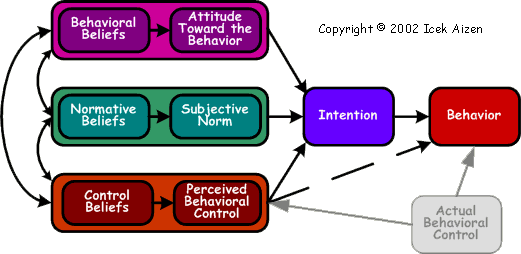On an individual level, I did find one approach that might help shed some light: theory of planned behavior (Ajzen, I. , 1991, The theory of planned behavior. Organizational Behavior and Human Decision Processes, 50, 179-211).
The theory of planned behavior offers a model where behavioral, normative and control beliefs influence respectively a persons (1) attitude toward behavior, (2) subjective norm and (3) percieved behavioral control. Together this guides a persons intentions, which steers the behavior.
 ·source and explanation (image: copyright 2002 Icek Aizen)
·source and explanation (image: copyright 2002 Icek Aizen)
…perceived behavioral control refer’s to people’s perception of the ease or difficulty of performing the behavior of interest. … perceived behavioral control can, and usually does, vary across situations and actions.
Again, so far no hard link to group behavior (or other external drivers, which is common in behavioral change theories). Although all boxes originate from an individual, cognitive self regulation point of view, there is no reason to neglect the fact that they can also act as interpersonal drivers within group behavior. To help make some constructive noise and help surface intentions an loyalty. According to Aizen, all intervision should target the beliefs, and through adjusted intention it will change behavior.